Do blue watermelons exist or is it an internet myth?
Watermelon is a familiar part of the summer menu. Even children know what a fruit with red pulp and dark seeds looks like. But not long ago, news about an amazing blue watermelon appeared on the Internet. The creators assured that this was a new variety, the pulp of which had an unusual color and unique taste. Everyone was invited to buy seeds and grow this unusual crop.
Do such fruits really exist or is it a hoax? In the article you will find a detailed answer to this question.
Japanese blue watermelon
The first mention of this unusual variety appeared on the Internet in May 2011.. The blue watermelon was developed in Japan and was called Lunar (or Asidus). According to sellers, it grew only in a few Japanese regions.

The creators of this miracle of selection claimed that the person who eats it changes their taste perception radically. Sour things seem sweet to him, salty things taste bitter, and plain water takes on a distinct orange flavor.
Interesting fact. The price of the new product corresponded to the amazing qualities stated in the description. Asidus cost 16,000 yen (about $200) per kilogram. But it did not scare off exotic lovers. There were plenty of people willing to try the unusual berry.
Fact or Fiction
Photos of berries with blue and blue pulp appeared on such resources as Snopes, Tumblr, Yahoo Answers and Pinterest and caused a lot of controversy and discussion. Some were sure that such an unusual color was the result of exposure to strong chemicals.These users discouraged others from experimenting with food.
 The topic of GMOs was often raised in discussions. The most popular was the version with chemical dyes that changed the usual red color of the fruit.
The topic of GMOs was often raised in discussions. The most popular was the version with chemical dyes that changed the usual red color of the fruit.
Japan and China have long established themselves as suppliers of very exotic things, so the blue watermelons didn’t stand out too much from the rest of the products. This is probably why users so easily accepted the existence of Asidus and boldly ordered it.
Some users reacted to these photos with disbelief. There were also those who believed that the rich shade of the flesh was the achievement not of breeders, but of Photoshop masters or other graphic editors.
Exposure
The suspicions of skeptics who doubt the achievements of Japanese breeders have been confirmed. Thanks to Google, we were able to locate the original photo of Asidus. It was an ordinary red watermelon, and its blue color turned out to be the result of color correction in a graphics editor. The news that caused such a resonance turned out to be an ordinary fake (deception).
Quite soon, a number of revealing videos appeared on the Internet.. On them, people showed how to give red pulp a rich blue tint in a few clicks.
This is interesting. Fictions about the amazing ability of blue watermelon to change the taste of food have a very real basis. The Magic Berry (Sunsepalum Dulcificum), which grows in West Africa, has this property. Its fruits contain glycoprotein and miraculin, which act on the taste buds of the tongue. After eating this fruit, the sour begins to seem sweet.
Growing blue watermelons
 The revelation did not bother the businessmen. The Chinese website Aliexpress continued to sell Asidus seeds.This the product turned out to be extremely popular and many people ordered it. Some even filmed the process or wrote about it on their social media pages.
The revelation did not bother the businessmen. The Chinese website Aliexpress continued to sell Asidus seeds.This the product turned out to be extremely popular and many people ordered it. Some even filmed the process or wrote about it on their social media pages.
Time passed, but the gullible buyers never saw any blue berries. The delivered seeds grew into ordinary red fruits. But most often they did not germinate at all. The reason was that often expired seeds were sent to buyers.
Representative of the Moscow Interregional Union of Gardeners V. Lukanin commented this situation like this: “Did you buy a blue watermelon? God grant that he grows up simple. It will be red. But the protection period for the buyer will already pass, because in 60 days you won’t have time to grow anything.”
This is true. Two months is not enough to get a harvest that will confirm the fact of deception. Some particularly cunning sellers even offer seeds out of season in order to completely protect themselves from a possible refund.
Traditional varieties of watermelons:
Customer reviews were also not long in coming.. Here are some of them:
- “Nonsense - ordinary, red grows from such seeds.”
- “I bought it, planted it, but in the end nothing grew.”
- “The seeds have arrived, we’ll try to grow them...” After 1.5 months, the review was updated: “The strawberries have sprouted!”
- “The goods did not arrive, return the money!”
Unfortunately, human gullibility is strong. They proved the dishonesty of the sellers and even found the original advertising photo of Asidus. It may seem like this issue is closed, but many people still believe in the existence of the blue watermelon. On the Internet you can find many articles describing this variety and even recipes. Some are still trying to grow it.

Unusual varieties of watermelons
Although the blue watermelon turned out to be a deception of enterprising and dishonest traders, in the world there are many varieties of this berry, the shape and colors of which are no less surprising. There are about 1,200 varieties of watermelons, and among them there are extremely unusual specimens.
This is interesting. We can judge the selection path of watermelon from the works of Renaissance artists. A still life painted by Giovanni Stanchi in the 17th century shows what this berry looked like 400 years ago. Its flesh had a different color, and the seeds were much larger.
Snow-white watermelon
 The white color of the pulp is considered to be a sign of an unripe fruit., or the result of strong chemical treatment. But there is a variety of watermelon for which this color is a characteristic feature. This is a variety called White Miracle.
The white color of the pulp is considered to be a sign of an unripe fruit., or the result of strong chemical treatment. But there is a variety of watermelon for which this color is a characteristic feature. This is a variety called White Miracle.
It was obtained by crossing a wild watermelon from South Africa. and its cultivated relative. The skin of the White Miracle is green with dark stripes and thin, and the flesh is uniformly white and translucent. It has a light strawberry and fresh cucumber flavor.
Do not confuse white and unripe watermelons. Berries that were picked ahead of schedule have a number of signs:
- A white coating is visible on the peel.
- The pulp is unevenly colored, loose and with voids.
- The seeds are white.
- The pulp often contains yellow or white streaks (a sign of the presence of nitrites).
You can't eat these watermelons!
Yellow watermelon
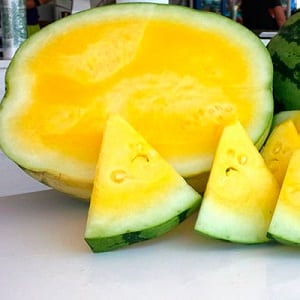 In Thailand, breeders managed to develop another unusual variety. Outwardly, it is completely unremarkable: small in size, oval in shape and green skin with dark stripes. But the pulp of this berry has a rich yellow color.
In Thailand, breeders managed to develop another unusual variety. Outwardly, it is completely unremarkable: small in size, oval in shape and green skin with dark stripes. But the pulp of this berry has a rich yellow color.
Like the White Miracle, this variety was obtained by crossing wild and cultivated plants. Later, similar berries were successfully bred in Russia and Spain. The Lunar variety, bred in Russia, has gained popularity in Asian countries. The Thais, Chinese and Spaniards liked yellow watermelons even more than red ones, but in Russia they were not particularly widespread.
Yellow watermelons are sweeter than red ones, and their fruits have fewer seeds.. In some varieties, gourmets distinguish the flavor of mango, pumpkin or lemon. In 2013, Russian breeders even managed to obtain a variety with a nutmeg flavor.
This is interesting. Yellow is the original color of watermelon pulp. Wild relatives of modern watermelons have small fruits with golden and bitter-tasting pulp.
Seedless watermelon
 For many watermelon lovers, the seeds spoil the pleasure. This problem was solved in the 40s and 50s. The Japanese managed to develop a seedless variety for the first time. The new product was quickly appreciated. Soon, similar varieties appeared in the USA, Venezuela, Bulgaria and Russia.
For many watermelon lovers, the seeds spoil the pleasure. This problem was solved in the 40s and 50s. The Japanese managed to develop a seedless variety for the first time. The new product was quickly appreciated. Soon, similar varieties appeared in the USA, Venezuela, Bulgaria and Russia.
The flesh of boneless watermelons is slightly looser and waterierthan regular ones, but at the same time it is sweeter. This is due to the higher sugar content. Outwardly, they do not stand out in any way: green peel with stripes and medium size.
Now these varieties are grown mainly in the USA and Israel.. In American supermarkets you can buy both whole fruits and those already cut in half or into quarters.
This is interesting:
The benefits of watermelon juice and how to prepare it correctly
Simple and effective watermelon masks for face and hair
Is it possible to eat watermelon on an empty stomach and when problems may arise
Square watermelon
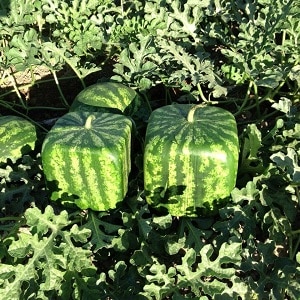 Manufacturers can surprise the buyer not only with an unusual color, but also with a non-standard shape. So, in the summer of 2007, cubic watermelons became widespread in Japan. Unlike the blue watermelon, this is not just another invention of merchants, but a real product.
Manufacturers can surprise the buyer not only with an unusual color, but also with a non-standard shape. So, in the summer of 2007, cubic watermelons became widespread in Japan. Unlike the blue watermelon, this is not just another invention of merchants, but a real product.
Its creation is dictated by rationality. Fruits of this shape are much more convenient to store and transport. They save space when stacking and do not roll during transportation.
These sweet cubes cost around $80. They are often purchased as an unusual gift.
This is interesting. The imagination of Japanese gardeners was not limited to one square shape. Now on sale you can find not only cubic watermelons, but also berries in the shape of a pyramid and even a human head.
Watermelon with white rind
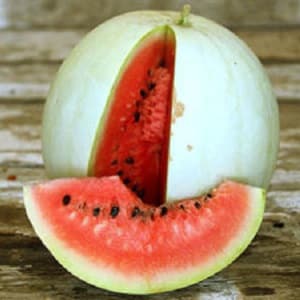 There is another variety of white watermelon. It was bred by American breeders and was named Navajo Winter. Its flesh is the usual red or pink color, and the peel is almost white. These watermelons are crunchy and sweet.
There is another variety of white watermelon. It was bred by American breeders and was named Navajo Winter. Its flesh is the usual red or pink color, and the peel is almost white. These watermelons are crunchy and sweet.
Navajo Winter easily tolerates lack of moisture. This makes it suitable for cultivation in arid areas. Another advantage of the variety is the ability to store it for a long time.
Harvest does not deteriorate for up to four months and retains its taste properties.
Black watermelon
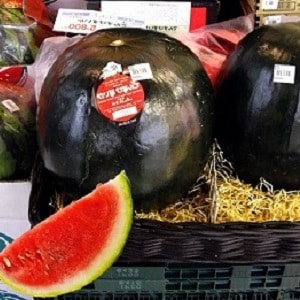 At the other end of the light spectrum is the result of the work of Japanese gardeners. In the 80s they managed to get a completely black watermelon. The variety grown in the city of Toma was named Densuke.
At the other end of the light spectrum is the result of the work of Japanese gardeners. In the 80s they managed to get a completely black watermelon. The variety grown in the city of Toma was named Densuke.
Densuke fruits are round and have a medium-thick skin.. The flesh is rich red, sweet and juicy. The taste of this watermelon is practically no different from ordinary green one.
Densuke is not cheap. The average price is about 25 thousand yen ($250) per piece. This high cost is due not only to the exotic colors of watermelons, but also to their rarity.Densuke is grown exclusively on the island of Hokkaido, and no more than 10,000 pieces go on sale per year.
This is interesting. The word "densuke" is made up of two characters meaning "rice field" and "help". The fact is that in the 80s there was a rice crop failure - this crop was the main source of income for Toma farmers. To save the business, it was decided to switch to growing unusual watermelons.
Dwarf watermelon
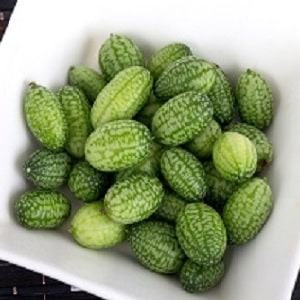 Of all the variety of watermelons, the smallest representative of this species is noteworthy — Melothria hummingbird is native to Africa. Its length is only a few centimeters. Outwardly, it looks like a smooth gherkin with longitudinal stripes.
Of all the variety of watermelons, the smallest representative of this species is noteworthy — Melothria hummingbird is native to Africa. Its length is only a few centimeters. Outwardly, it looks like a smooth gherkin with longitudinal stripes.
This variety is popular as a snack and as an ingredient for summer salads.. But sweet lovers will be disappointed. Melotria tastes more like a cucumber. It is because of this that watermelon received another name - African cucumber. Some people think of Melotria Hummingbird as a cucumber with the appearance of a watermelon, while others refer to it as a watermelon with a cucumber flavor.
African cucumber can also be grown in Russia. Its seeds are sold on specialized trading platforms in online supermarkets. There are many reviews posted on forums and websites from those who actually managed to grow them and get a harvest.

Conclusion
Sellers from China once again confirmed the need to be skeptical about advertising persuasion. The blue watermelon turned out to be just a cunning marketing ploy that forced gullible buyers to fork out money.
However, there are many real original varieties of this berry in the world. Be careful and bon appetit!